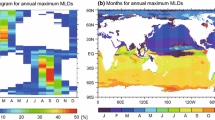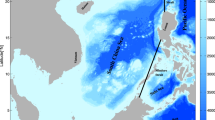Abstract
Using heat budget diagnosis of ocean mixed layer from the Global Ocean Data Assimilation System, the spatial distribution of the leading modes of the heat budget was examined. The analysis was for the tropical Pacific in 1979–2013 and was based on combined empirical orthogonal function (CEOF) analysis. The interdecadal changes of the leading modes and their associations with El Niño-Southern Oscillation (ENSO) were also analyzed. The first leading CEOF mode (CEOF1) corresponds to the ENSO mature phase. The contribution from the zonal advection was relatively small along the equator, except the region near the Pacific coast of Central America. The vertical entrainment and diffusion (surface heat flux) had pronounced maxima with positive (negative) values along the equatorial central and eastern Pacific. The meridional advection displayed a different spatial pattern with large positive values on both sides of the equator and smaller values along the equator. The total meridional advection anomaly was mainly determined by advection of anomalous temperature by climatological current responsible for broadening of the ENSO SSTA pattern meridionally. The zonal advection varied almost simultaneously with the tendency of ocean temperature anomaly in the mixed layer. The second leading CEOF mode (CEOF2) included contribution to SSTA tendency during the ENSO developing phase. The distribution pattern and amplitude of the zonal advection in the eastern Pacific in CEOF2 was similar to but with opposite sign to that in CEOF1. The amplitudes of the other dynamical and thermodynamical terms were smaller than that in CEOF1 and spatial distributions displayed an opposite variation between the Pacific coast of Central America and central and eastern tropical Pacific in CEOF2. A comparison of two periods (1979–1999 and 2000–2013) suggested that coupling in the tropical Pacific weakened at ENSO time scales and shifted to a relatively higher frequency regime (from 2 to 4 years averaged in 1979–1999 to 1.5–3 years) after 2000.












Similar content being viewed by others
References
Barnston AG, Chelliah M, Goldenberg SB (1997) Documentation of a highly ENSO-related SST region in the equatorial Pacific. Atmos Ocean 35:367–383
Battisti DS, Hirst AC (1989) Interannual variability in a tropical atmosphere-ocean model: influence of the basic state, ocean geometry and nonlinearity. J Atmos Sci 46:1687–1712
Bay T, Dommenget D (2014) Comparing the spatial structure of variability in two datasets against each other on the basis of EOF-modes. Clim Dyn 42:1631–1648
Behringer DW (2005) The global ocean data assimilation system (GODAS) at NCEP, 11th Symposium on Integrated Observing and Assimilation Systems for the Atmosphere, Oceans, and Land Surface (IOAS-AOLS), San Antonio, TX, Amer. Meteor. Soc., 3.3 [Available online at https://ams.confex.com/ams/87ANNUAL/webprogram/11IOAS.html]
Behringer DW, Xue Y (2004) Evaluation of the global ocean data assimilation system at NCEP: the Pacific Ocean. Preprints, Eighth Symp. on Integrated Observing and Assimilation Systems for Atmosphere, Oceans, and Land Surface, Seattle, WA, Amer. Meteor. Soc., 2.3 [Available online at http://ams.confex.com/ams/84Annual/techprogram/paper_70720.htm]
Bjerknes J (1969) Atmospheric teleconnections from the equatorial Pacific. Mon Weather Rev 97:163–172
Clarke AJ (2010) Analytical theory for the quasi-steady and low-frequency equatorial ocean response to wind forcing: the ‘tilt’ and ‘warm water volume’ modes. J Phys Ocean 40(1):121–137
Dommenget D, Latif M (2002) A cautionary note on the interpretation of EOFs. J Climate 15:216–225
Glantz MH (2000) Currents of change: impacts of El Niño and La Niña on climate and society. Cambridge University Press, Cambridge, UK, p 266. ISBN 052178672X
Hu Z-Z, Nitta T (1996) Wavelet analysis of summer rainfall over North China and India and SOI using 1891–1992 data. J Meteorol Soc Jpn 74(6):833–844
Hu Z-Z, Kumar A, Jha B, Wang W, Huang B, Huang B (2012) An analysis of warm pool and cold tongue El Niños: air-sea coupling processes, global influences, and recent trends. Climate Dyn 38(9–10):2017–2035. doi:10.1007/s00382-011-1224-9
Hu Z-Z, Kumar A, Ren H-L, Wang H, L’Heureux M, Jin F-F (2013a) Weakened interannual variability in the tropical Pacific Ocean since 2000. J Climate 26(8):2601–2613. doi:10.1175/JCLI-D-12-00265.1
Hu Z-Z, Kumar A, Huang B, Zhu J (2013b) Leading modes of upper ocean temperature interannual variability along the equatorial Atlantic Ocean in NCEP GODAS. J Climate 26(13):4649–4663. doi:10.1175/JCLI-D-12-00629.1
Huang B, Schneider EK (1995) The response of an ocean general circulation model to surface wind stress produced by an atmospheric general circulation model. Mon Weather Rev 123:3059–3085
Huang B, Xue Y, Zhang D, Kumar A, McPhaden MJ (2010) The NCEP GODAS ocean analysis of the tropical Pacific mixed layer heat budget on seasonal to interannual time scales. J Climate 23:4901–4925
Huang B, Xue Y, Wang H, Wang W, Kumar A (2012) Mixed layer heat budget of the El Niño in NCEP climate forecast system. Climate Dyn 39(1–2):365–381. doi:10.1007/s00382-011-1111-4
Jin F-F (1997a) An equatorial ocean recharge paradigm for ENSO. Part I: conceptual model. J Atmos Sci 54:811–829
Jin F-F (1997b) An equatorial ocean recharge paradigm for ENSO. Part II: a stripped-down coupled model. J Atmos Sci 54:830–847
Kanamitsu M et al (2002) NCEP-DOE AMIP-II Reanalysis (R-2). Bull Am Met Soc 83:1631–1643
Kang I-S, An S-I, Jin F-F (2001) A systematic approximation of the SST anomaly equation for ENSO. J Meteorol Soc Jpn 79:1–10
Kao H-Y, Yu J-Y (2009) Contrasting eastern-Pacific and central-Pacific types of ENSO. J Climate 22:615–632
Kug J-S, Jin F-F, An S-I (2009) Two types of El Niño events: cold tongue El Niño and warm pool El Niño. J Climate 22:1499–1515. doi:10.1175/2008JCLI2624.1
Kumar A, Hu Z-Z (2014) Interannual and interdecadal variability of ocean temperature along the equatorial Pacific in conjunction with ENSO. Climate Dyn 42(5–6):1243–1258. doi:10.1007/s00382-013-1721-0
Lau N-C, Philander SGH, Nath MJ (1992) Simulation of ENSO-like phenomena with a low-resolution coupled GCM of the global ocean and atmosphere. J Climate 5(4):284–307
Lee T, McPhaden MJ (2010) Increasing intensity of El Niño in the central equatorial Pacific. Geophys Res Lett 37:L14603. doi:10.1029/2010GL044007
McPhaden MJ (2012) A 21st century shift in the relationship between ENSO SST and warm water volume anomalies. Geophys Res Lett 39:L09706. doi:10.1029/2012GL051826
Meinen CS, McPhaden MJ (2000) Observations of warm water volume changes in the equatorial Pacific and their relationship to El Niño and La Niña. J Climate 13:3551–3559
National Research Council (2010) Assessment of Intraseasonal to Interannual Climate Prediction and Predictability. The National Academies Press, Washington, p 192. ISBN 0-309-15183-X
North GR, Bell TL, Cahalan RF, Moeng FJ (1982) Sampling errors in the estimation of empirical orthogonal functions. Mon Weather Rev 110:699–706
Picaut J, Masia F, du Penhoat Y (1997) An advective-reflective conceptual model for the oscillatory nature of the ENSO. Science 277:663–666
Rasmusson EM, Carpenter TH (1982) Variation in tropical sea surface temperature and surface wind fields associated with Southern Oscillation/El Niño. Mon Weather Rev 110:354–384
Reynolds RW, Rayner NA, Smith TM, Stokes DC, Wang W (2002) An improved in situ and satellite SST analysis for climate. J Climate 15:1609–1625
Sarachik ES, Cane MA (2010) The El Niño-Southern Oscillation Phenomenon. Cambridge University Press, London 384 pp
Schopf PS, Suarez MJ (1987) Vacillations in a coupled ocean-atmosphere model. J Atmos Sci 45:549–566
Walker GT (1923) Correlations in seasonal variations of weather, VIII. A preliminary study of world weather I. Mem India Meteorol Dep 23:75–131
Wang C (2001) A unified oscillator model for the El Niño-Southern Oscillation. J Climate 14:98–115
Wang W, Chen M, Kumar A (2010) An assessment of the CFS real-time seasonal forecasts. Weather Forecast 25:950–969
Wen C, Kumar A, Xue Y, McPhaden MJ (2014) Changes in tropical pacific thermocline depth and their relationship to ENSO after 1999. J Climate 27:7230–7249
Wyrtki K (1975) E1 Niño-the dynamic response of the equatorial Pacific Ocean to atmospheric forcing. J Phys Ocean 5:572–584
Wyrtki K (1985) Water displacements in the Pacific and the genesis of El Niño cycles. J Geophys Res 90(C4):7129–7132
Xiang B, Wang B, Li T (2013) A new paradigm for the predominance of standing Central Pacific warming after the late 1990s. Climate Dyn 41(2):327–340. doi:10.1007/s00382-012-1427-8
Yeh S, Kug J, Dewitte B, Kwon M, Kirtman BP, Jin F-F (2009) El Niño in a changing climate. Nature 461(7263):511–514
Zebiak SE, Cane MA (1987) A model El Niño/Southern Oscillation. Mon Wea Rev 115:2262–2278
Zhang R-H, Levitus S (1996) Structure and evolution of interannual variability of the tropical Pacific upper ocean temperature. J Geophys Res 101:20501–20524
Zhang Q, Kumar A, Xue Y, Wang W, Jin F-F (2007) Analysis of ENSO cycle in NCEP coupled forecast model. J Climate 20:1265–1284
Zhu J, Huang B, Balmased MA (2012) An ensemble estimation of the variability of upper-ocean heat content over the tropical Atlantic Ocean with multi-ocean reanalysis products. Climate Dyn 39(3–4):1001–1020. doi:10.1007/s00382-011-1189-8
Acknowledgments
We appreciated the insight comments and suggestions from two reviewers, which significantly improve the paper. We discussed with Prof. Fei-Fei Jin during early stage of this work. Bohua Huang is supported by grants from NSF (ATM-0830068), NOAA (NA09OAR4310058), and NASA (NNX09AN50G). The procedure of the heat budget calculation used in this work was developed by Dr. Boyin Huang and is maintained by Dr. C. Wen. The scientific results and conclusions, as well as any view or opinions expressed herein, are those of the author(s) and do not necessarily reflect the views of NWS, NOAA, or the Department of Commerce.
Author information
Authors and Affiliations
Corresponding author
Rights and permissions
About this article
Cite this article
Hu, ZZ., Kumar, A. & Huang, B. Spatial distribution and the interdecadal change of leading modes of heat budget of the mixed-layer in the tropical Pacific and the association with ENSO. Clim Dyn 46, 1753–1768 (2016). https://doi.org/10.1007/s00382-015-2672-4
Received:
Accepted:
Published:
Issue Date:
DOI: https://doi.org/10.1007/s00382-015-2672-4




